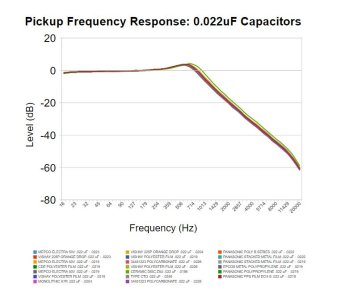GuitarStv
Sock Market Trader
Re: The best cap material for tone pot
They did.
If you read the legends of the graphs provided, you will see the exact measured values of the caps tested . . . many of which are identical, or less than 1% different from others in the same graph.
Can you reference the data points you're drawing that from? From what I am seeing, their findings show no difference between material type when taking into account the actual value of the capacitor. Which is what they concluded.
I don't see why they didn't group some caps with the same measured value and test and compare those.
They did.
If you read the legends of the graphs provided, you will see the exact measured values of the caps tested . . . many of which are identical, or less than 1% different from others in the same graph.
Their conclusion isn't congruent with their findings lol.
Can you reference the data points you're drawing that from? From what I am seeing, their findings show no difference between material type when taking into account the actual value of the capacitor. Which is what they concluded.


